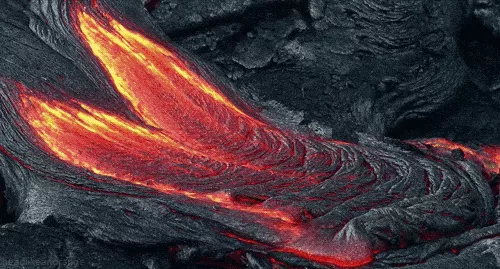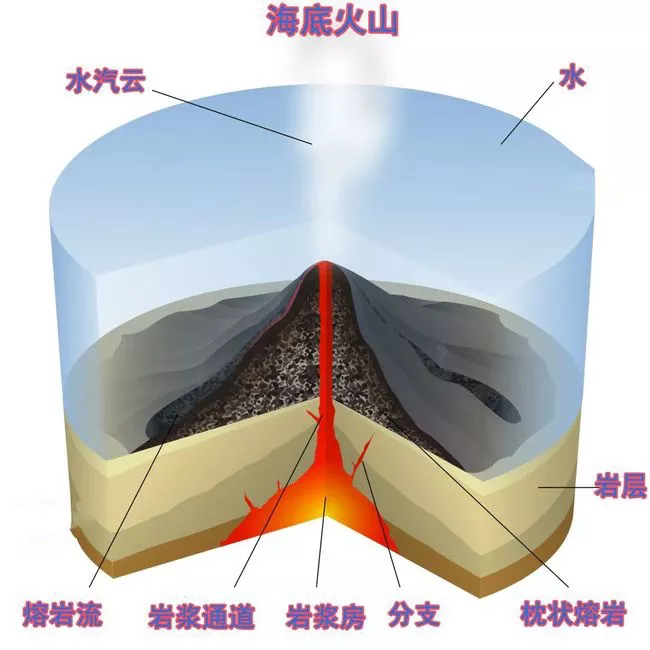火山喷发的现象,是地壳下面的岩浆冲出地壳时造成的。由于地球内部温度很高,压力极大,所以岩石在800°C以上的高温下会变成通红的炽热液体,随着温度的提高,岩浆产生的物理和化学反应可以施放出有毒气体,好像水中的气泡一样,上升到岩浆表面破裂。这就是人们看到的岩浆沸腾的样子。火山喷发的时候,岩浆从地下喷发出来,汇成一条沸腾的河流奔涌向前。直到岩浆逐渐冷却,形成玄武岩或者橄榄石。
Volcanic eruptions are caused when magma bursts out of the earth’s crust. Because the earth’s interior is very hot and under great pressure, rocks turn into a red-hot, fiery liquid at temperatures above 800°C. As the temperature increases, the physical and chemical reactions produced by the magma can exert toxic gases that rise to the surface of the magma and rupture as if they were bubbles in water. This is how people see magma boiling. When a volcano erupts, magma erupts from the ground and flows into a boiling river that rushes forward until the magma gradually cools and forms basalt or peridot.

火山爆发的壮观及随之而来的风险常常引发媒体及公众的关注,但人们很容易忽略地球上约70%的火山活动是在海底发生的。海底火山的喷发虽远离人群,却增加了海上和航空交通的风险。
The spectacular nature of volcanic eruptions and the attendant risks often draw media and public attention, but it is easy to overlook that about 70% of the earth’s volcanic activity takes place under the sea. Eruptions of submarine volcanoes, although far from the crowd, increase the risk to marine and air traffic.
所谓海底火山,就是形成于浅海和大洋底部的各种火山。包括死火山和活火山。地球上的火山活动主要集中在板块边界处,而海底火山大多分布于大洋中脊与大洋边缘的岛弧处。板块内部有时也有一些火山活动,但数量非常少。海底火山可分3类,即边缘火山、洋脊火山和洋盆火山,它们在地理分布、岩性和成因上都有显著的差异。
Submarine volcanoes are those forming at the bottom of shallow seas and oceans. They include both extinct and active volcanoes. Volcanic activity on earth is concentrated at plate boundaries, while submarine volcanoes are mostly located at mid-ocean ridges and island arcs at the edge of the oceans. There are sometimes some volcanic activities inside the plates, but the number is very small. Submarine volcanoes can be divided into three categories, namely, margin volcano, ridge volcano, and ocean basin volcano, which have significant differences in geographic distribution, lithology, and genesis.

海底火山喷发时,在水较浅、水压力不大的情况下,常有壮观的爆炸,这种爆炸性的海底火山爆发时,产生大量的气体,主要是来自地球深部的水蒸气、二氧化碳及一些挥发性物质,还有大量火山碎屑物质及炽热的熔岩喷出,在空中冷凝为火山灰、火山弹、火山碎屑。
When submarine volcanoes erupt, there are often spectacular explosions when the sea is shallow and has little water pressure. When such submarine volcanoes erupt, they produce large amounts of gas, mainly water vapor, carbon dioxide and some volatile substances from the deep part of the earth, as well as large amounts of volcanic debris material and hot lava ejected and condensed in the air as volcanic ash, volcanic bombs and volcanic debris.

那么问题来了,为什么海水无法浇灭海底火山吗?其实这里面的原因十分简单,因为虽然我们将其称为海底火山,但是它本身其实和“火”并没有太大的关联,只是过去的人们不是很了解火山喷发的原理,加上岩浆的高温,才有了火山这个名字。海底火山喷出来的火并不是陆地上的明火,以水灭火的原理是把燃烧物与空气隔开,但火山岩浆的喷发是高压所致,不需要空气,因此海水对海底火山喷发的岩浆只能降温而无法扑灭。
Then there is a question that why seawater cannot extinguish the submarine volcano? In fact, the reason is very simple. Although we call it submarine volcano, it itself is actually not very relevant with “fire”. In the past people did not understand the principle of volcanic eruptions, coupled with the high temperature of magma, so they named it after volcano. The fire from the submarine volcanoes is not an open fire on land and the principle of fire extinguishing with water is to separate the burning material from the air, but the eruption of volcanic magma is caused by high pressure and it does not require air, so the seawater can only cool down magma from the submarine volcano and cannot extinguish it.

海底火山起初只是沿洋底裂谷溢出的熔岩流,以后逐渐向上增高。大部分海底火山喷发的岩浆在到达海面之前就被海水冷却,不再活动了。所以,人们从来没有真正看到过海底火山爆发的景象。至多只是看到海底的熔岩泉不断冒出新的岩浆形成新的火成岩。美国一个潜水探险队的两个成员,曾经冒着生命危险探索夏威夷群岛火山。在水面下100英尺的深度,他们拍摄到了不断从海底火山口流出的熔岩河流,沿着火山的山坡向海底奔腾而下,而周围的海水温度被加热到100°C以上。如果没有先进的潜水设备,他们根本就不可能靠近海底的岩浆。
Submarine volcanoes are initially lava flows that overflow along the ocean floor rift, and then gradually increase in height upward. Most of the lava erupted from submarine volcanoes is cooled by seawater before it reaches the surface and is no longer active. Therefore, people have never really seen the sight of undersea volcanic eruptions. At best, new lava is seen emerging from lava springs on the sea floor to form new igneous rocks. Two members of a U.S. diving expedition once risked their lives to explore the volcanoes of the Hawaiian Islands. At a depth of 100 feet below the surface, they photographed rivers of lava constantly flowing from submarine craters, rushing down the slopes of the volcanoes toward the sea floor, while the surrounding seawater was heated to be over 100°C. Without advanced diving equipment, it would have been impossible for them to get close to the lava at the bottom of the sea.
海底火山在喷发中不断向上生长,会露出海面形成火山岛。1796 年,太平洋北部阿留申群岛中间的海底,火山不断喷发,熔岩越积越多,几年后,一个面积30平方公里的火山岛就出现在海面上。在距离澳大利亚东岸约1600公里的太平洋上,有一个小岛,叫做法尔康岛。1915年这个小岛突然消失,但是,11 年后它又重新冒出了海面。原来这就是海底火山喷发和波浪作用造成的。
Submarine volcanoes grow upward in eruptions, which can expose on the surface of the sea to form volcanic islands. In 1796, volcanoes continued to erupt at the bottom of the sea in the middle of the Aleutian Islands in the northern Pacific Ocean where lava accumulated more and more. And a few years later, a volcanic island with an area of 30 square kilometers appeared on the surface of the sea. In the Pacific Ocean, about 1,600 km from the east coast of Australia, there was a small island called Falcon Island. In 1915, this island suddenly disappeared, but 11 years later it reappeared on the surface. It turns out that the Island was caused by volcanic eruption and wave action under the sea.

参考资料:
[1]地质矿产部地质辞典办公室.地质大辞典(四)矿床地质、应用地质分册:地质出版社,2005
[2]于志刚.海洋地质:海洋出版社,2009
投稿者:王佳丽 硕士研究生
审核导师:万 逸 研究员 曾姝 助理研究员
 公众号
公众号